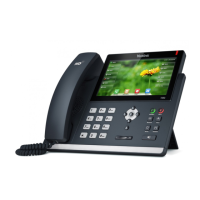Administrator’s Guide for SIP-T2 Series/T19(P) E2/T4 Series/CP860 IP Phones
866
The port on which User B is
prepared to receive the RTP data is
specified.
INVITE—Proxy Server to User
B
The proxy server maps the SIP URI in the
To field to User B. The proxy server
sends the INVITE message to User B.
180 Ringing—User B to Proxy
Server
User B sends a SIP 180 Ringing response
to the proxy server. The 180 Ringing
response indicates that the user is being
alerted.
180 Ringing—Proxy Server to
User A
The proxy server forwards the 180
Ringing response to User A. User A
hears the ring-back tone indicating that
User B is being alerted.
302 Move Temporarily—User
B to Proxy Server
User B sends a SIP 302 Moved
Temporarily message to the proxy
server. The message indicates that User
B is not available at SIP phone B. User B
rewrites the contact-URI.
ACK—Proxy Server to User B
The proxy server sends a SIP ACK to
User B, the ACK message notifies User B
that the proxy server has received the
ACK message.
302 Move Temporarily—Proxy
Server to User A
The proxy server forwards the 302
Moved Temporarily message to User A.
ACK—User A to Proxy Server
User A sends a SIP ACK to the proxy
server. The ACK message notifies the
proxy server that User A has received
the ACK message.
INVITE—User A to Proxy
Server
User A sends a SIP INVITE request to the
proxy server. In the INVITE request, a
unique Call-ID is generated and the
Contact-URI field indicates that User A
requests the call.
INVITE—Proxy Server to User
C
The proxy server forwards the SIP
INVITE request to User C.
180 Ringing—User C to Proxy
Server
User C sends a SIP 180 Ringing
response to the proxy server. The 180

